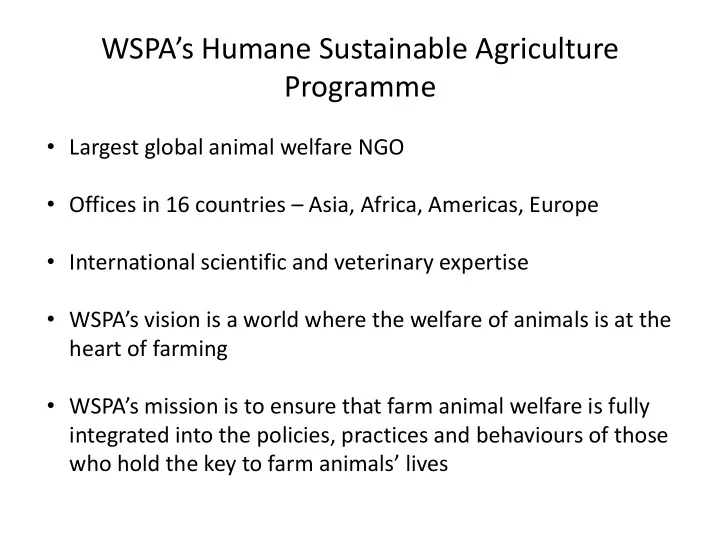

WSPA’s Humane Sustainable Agriculture Programme • Largest global animal welfare NGO • Offices in 16 countries – Asia, Africa, Americas, Europe • International scientific and veterinary expertise • WSPA’s vision is a world where the welfare of animals is at the heart of farming • WSPA’s mission is t o ensure that farm animal welfare is fully integrated into the policies, practices and behaviours of those who hold the key to farm animals’ lives
What is animal welfare? Animal welfare: the physical and mental well-being of animals. Five freedoms: hunger and thirst, pain and disease, discomfort and shelter, but also natural behaviour, free of fear and distress Based on their breed (genetics), their environment (how they live), their management (husbandry) and the interactions between these
Farm animal welfare: good for people, business and greater sustainability Economics, business, livelihood Environment Public health Animals in food production Water, land and Sufficient and safe natural resources food production 3
Why care about animal welfare? Three approaches: • Improve individual animal health • Incorporating animal welfare in the system • Integrating farm animal welfare from the start And… Wider impact of animal welfare – e.g. carbon
Pasture based dairy – LELBREN, Kenya
Why pasture? Animal welfare integral to the system of production Why pasture: • To boosting yields – attempted zero grazing but…. • Artificial insemination services unreliable • Lack of breed choice and pedigree records • High operational costs • Supplementary feeds unavailable • Poor health and infertility of the dairy cows – fast turnover and replacement Now: Crossbreeds, healthier, more resilient to local environmental conditions Pasture – low cost, low labour, more reliable Ability to boost production in within a low input system Better animal welfare Good for animal welfare, highly sustainable, sound livelihoods
Designed for good welfare ? • Pig sham chewing
Designing animal welfare into farming systems “The animal fit for the environment, fit for animal” • Animal’s natural way of being – their telos or nature and behaviour • Reduce animal stress – boost productivity • Reduce hazards such as injury (people and animals) • Easy care, resilient breeds - limiting the increased need for human labour and minimising e.g. painful mutilations. • Utilise local and traditional knowledge
Wider benefits of animal welfare and pasture Can improvements in dairy animal welfare result in GHG emissions reductions? • Prevailing view: increasing yield per cow decreases GHG emissions per kg. • Pursuit of ever increasing yields has been one of the biggest drivers of poor welfare in dairy cows. • Our research demonstrates animal welfare improvements have the potential to deliver cost effective GHG emissions reductions. • Systems oriented solely to high yields don’t necessarily have the lowest emissions when milk and beef products from a system are combined.
Pasture dairy systems have similar carbon footprint to maximal milk yield systems Dual purpose (e.g. Montbéliarde) Milk optimised (e.g. Holstein) Herd size: 144,000 cows Herd size: 114,000 cows Milk yield : 6,943 litres / year Milk yield : 8,733 litres / year Calving interval : 403 days Calving interval : 432 days R eplac ement rate: 20% R eplac ement rate: 25% 28,500 cull cows 101,000 28,500 cull cows 68,000 (7.9 k tonnes beef) calves for beef (7.0 k tonnes beef) calves for beef 1bn litres 1bn litres
Promoting ‘optimised’ farming • Optimal yields, truly sustainable • Enabling pasture farmers to succeed – Infrastructure, vet services, marketing • Policy reflects the value of pasture based agriculture – E.g. Global agenda, COP implementation • Research programme priority – Reflects real resource use and impact (LCAs and co- products – Wider implications for animal welfare, environment, livelihoods
Robust pasture-based vs. high input – high output farming systems – which solution for the future?
Recommend
More recommend